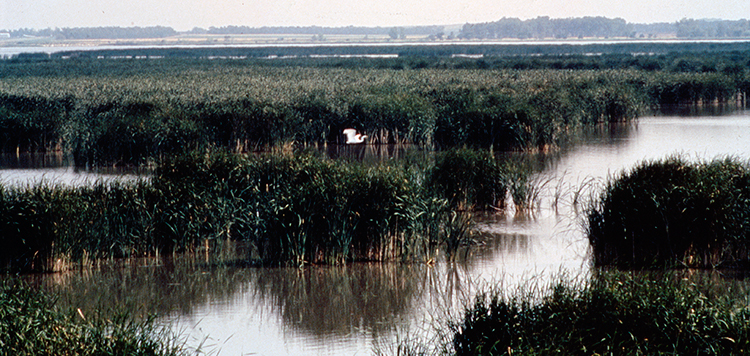Wetlands

Wetlands form when land is saturated by shallow water for an extended period, depriving the soil of oxygen. Some wetlands stay saturated year round, while others dry up during long dry periods with no precipitation. All types of environments, from tundra to tropical, support wetlands, which vary widely in size, shape, and character. Antarctica is the only continent without wetlands.
Wetlands are classified in two major categories—coastal and inland—depending on where they are located. They are known by a variety of names—marshes, playas, swamps, potholes, bogs, fens, and pocosins—based on their attributes. Kansas has marshes and playas.
Historically, wetlands were often considered a nuisance. They attracted disease-carrying flies and mosquitoes, sometimes stank, and covered land that could otherwise be used for farming or cities. As a result, more than half of the nation’s wetlands were drained and filled for cropland or development. In the late 1700s, Kansas had an estimated 841,000 acres of wetlands. Now it has about 435,000. Other Midwestern states, such as Ohio, Indiana, Illinois, and Iowa, have lost more than 85% of their wetlands.
As people have learned more about the environmental benefits of wetlands, many of the remaining acres are being protected or restored. Wetlands catch and store water that slowly seeps down into aquifers. From there, it can be pumped out for drinking water, industry, and irrigation. Wetlands also provide flood control, filter out pollutants, and provide essential habitat for wildlife.
Wetlands in Kansas
Most Kansas marshes are in the eastern two-thirds of the state, and tens of thousands of small, intermittent playas are scattered across the western half. Almost all of the marshes and playas have been altered from their natural state. At Cheyenne Bottoms in central Kansas—the largest wetland in the interior of the United States—dikes, dams, and pump stations control flooding and maintain water in the marsh for migratory birds during dry periods. Hundreds of animal species depend on Cheyenne Bottoms, including geese, ducks, whooping cranes, pelicans, sandpipers, muskrats, bobcats, tiger salamanders, chorus frogs, crayfish, and dragonflies.
The Kansas Department of Wildlife, Parks and Tourism (KDWPT) manages designated wildlife areas at Cheyenne Bottoms, Jamestown Marsh in north-central Kansas, and the Marais des Cygnes wetland area in east-central Kansas. The U.S. Fish and Wildlife Service manages four National Wildlife Refuges (NWR) in Kansas that include wetland areas. They are Quivira NWR in central Kansas, Kirwin NWR in northwestern Kansas, Marais des Cygnes NWR adjacent to the KDWPT Marais des Cygnes wildlife area, and Flint Hills NWR in east-central Kansas.
Sources
Wetlands Protection and Restoration, U.S. Environmental Protection Agency
Cheyenne Bottoms Wildlife Area, Kansas Department of Wildlife and Parks
U.S. Fish and Wildlife Service, Refuge List by State
Loss of Wetlands in the Southwestern United States, U.S. Geological Survey